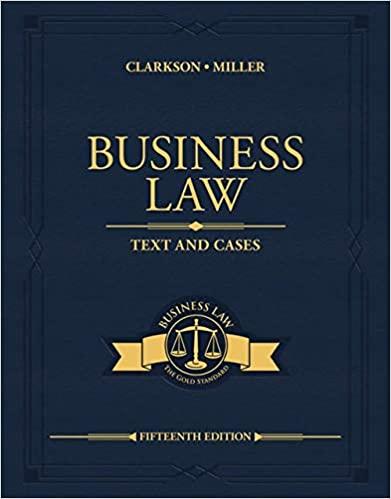Question
Which of the following dispute resolution processes are forms of unilateral action: Question 1 options: A inaction and acquiescence B negotiation C self-help D no
Which of the following dispute resolution processes are forms of unilateral action:
Question 1 options:
| A | inaction and acquiescence |
| B | negotiation |
| C | self-help |
| D | no action |
Question 2 (1 point)
Which of the following dispute resolution processes will result in a winner and a loser?
Question 2 options:
| A | court-annexed arbitration and litigation |
| B | inaction |
| C | private mediation |
| D | litigation and private mediation |
Question 3 (1 point)
Which of the following may actively participate in inaction?
Question 3 options:
| A | the aggrieved party only |
| B | both parties |
| C | a jury |
| D | a neutral third party or parties |
Question 4 (1 point)
Inaction is classified as
Question 4 options:
| A | third party adjudication in dispute resolution |
| B | bilateral action in dispute resolution |
| C | unilateral action in dispute resolution |
| D | third party assistance in dispute resolution |
Question 5 (1 point)
Inaction establishes binding precedent.
Question 5 options:
| A | True |
| B | False |
Question 6 (1 point)
Inaction may save the aggrieved party transaction costs.
Question 6 options:
| A | True |
| B | False |
Question 7 (1 point)
Acquiescence must be an act; it cannot be an omission
Question 7 options:
| A | True |
| B | False |
Question 8 (1 point)
Which of the following may actively participate in acquiescence as a dispute resolution process:
Question 8 options:
| A | the other party to the dispute |
| B | the attorney for the party who acquiesces |
| C | a neutral third party |
| D | the party that acquiesces |
Question 9 (1 point)
Some of the advantages of acquiescence are that it:
Question 9 options:
| A | reduces transaction costs for the party who acquiesces and preserves legal rights |
| B | provides finality to the dispute if the party who acquiesces chooses not to seek additional relief |
| C | Both A and B |
| D | None of the above |
Question 10 (1 point)
In negotiation, the jury is the finder of fact and the judge is the finder of law.
Question 10 options:
| A | True |
| B | False |
Question 11 (1 point)
In negotiation, the court requires the parties be represented by legal counsel.
Question 11 options:
| A | True |
| B | False |
Question 12 (1 point)
In negotiation, the outcome is more based on the needs and interests of the parties rather than the law.
Question 12 options:
| A | True |
| B | False |
Question 13 (1 point)
Which of the following always participate in negotiation as a dispute resolution process:
Question 13 options:
| A | the aggrieved party and the other party to the dispute |
| B | the aggrieved party only |
| C | unilateral action to in dispute resolution |
| D | Both B and C |
Question 14 (1 point)
Early neutral evaluation is classified as:
Question 14 options:
| A | unilateral action in dispute resolution |
| B | bilateral action in dispute resolution |
| C | third-party evaluation as a prelude to dispute resolution |
| D | third-party adjudication in dispute resolution |
Question 15 (1 point)
Early neutral evaluation is more of a case management tool than a dispute resolution process.
Question 15 options:
| A | True |
| B | False |
Step by Step Solution
There are 3 Steps involved in it
Step: 1

Get Instant Access to Expert-Tailored Solutions
See step-by-step solutions with expert insights and AI powered tools for academic success
Step: 2

Step: 3

Ace Your Homework with AI
Get the answers you need in no time with our AI-driven, step-by-step assistance
Get Started


